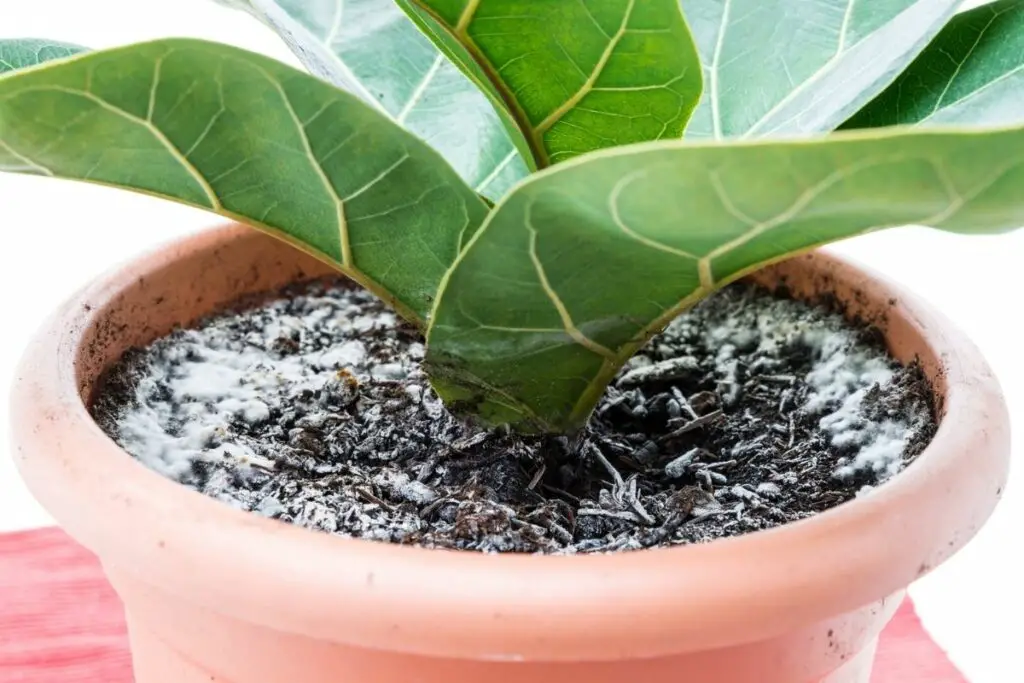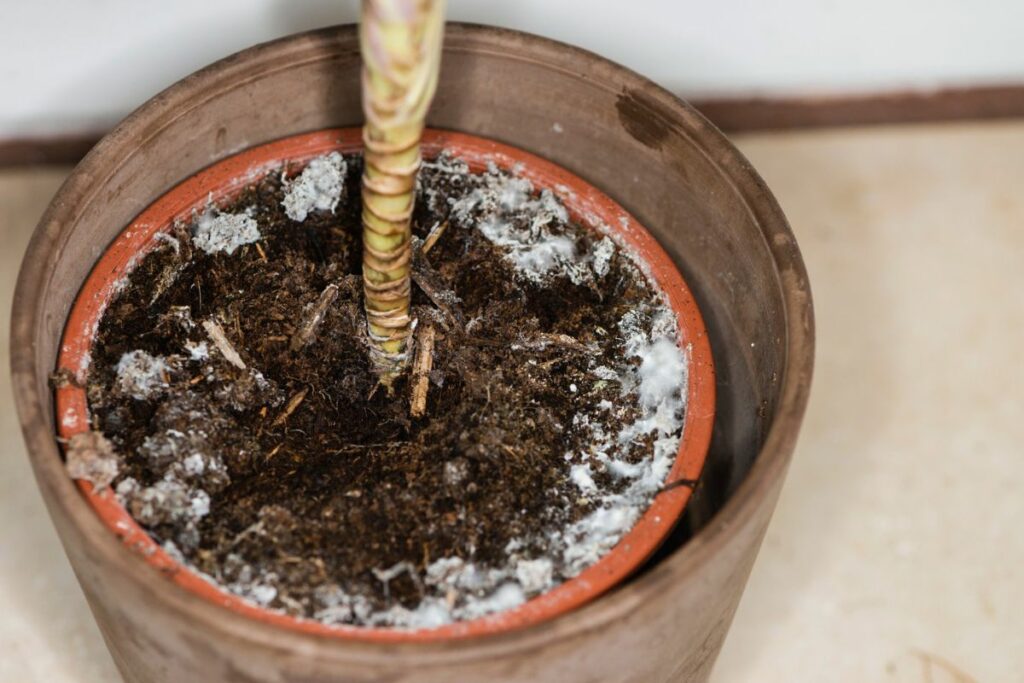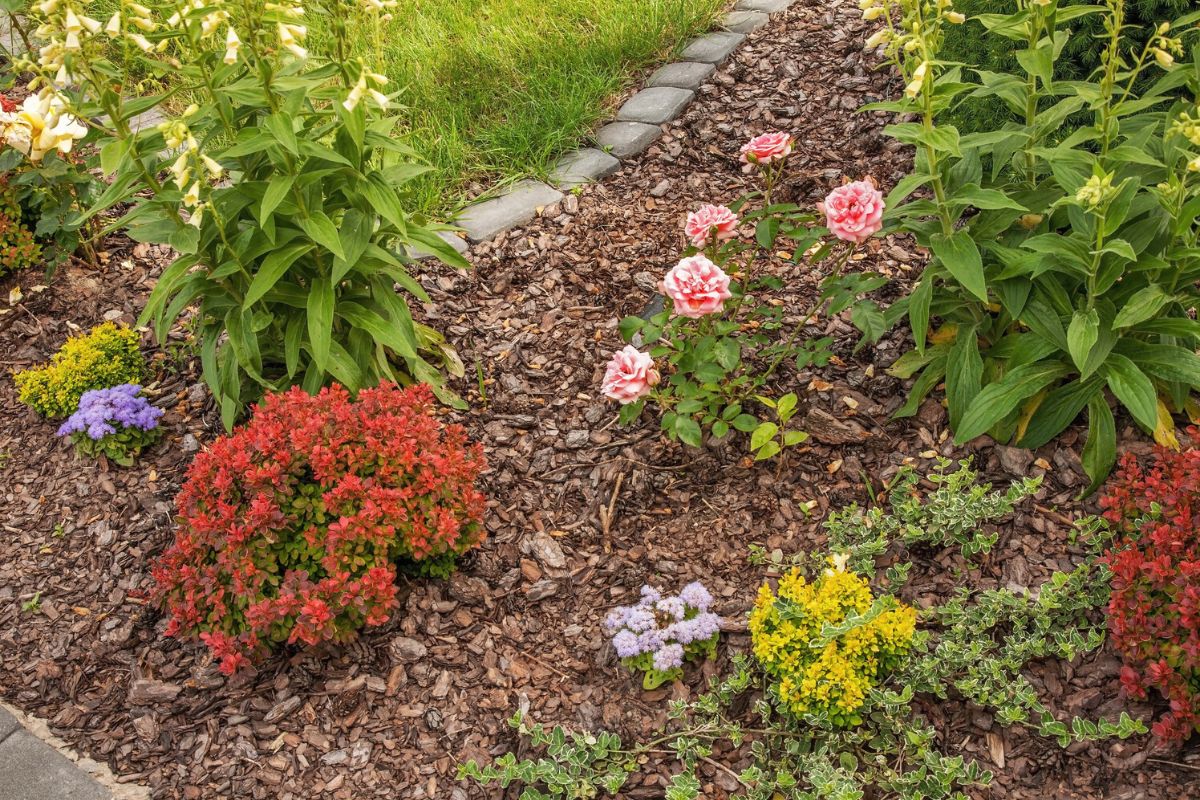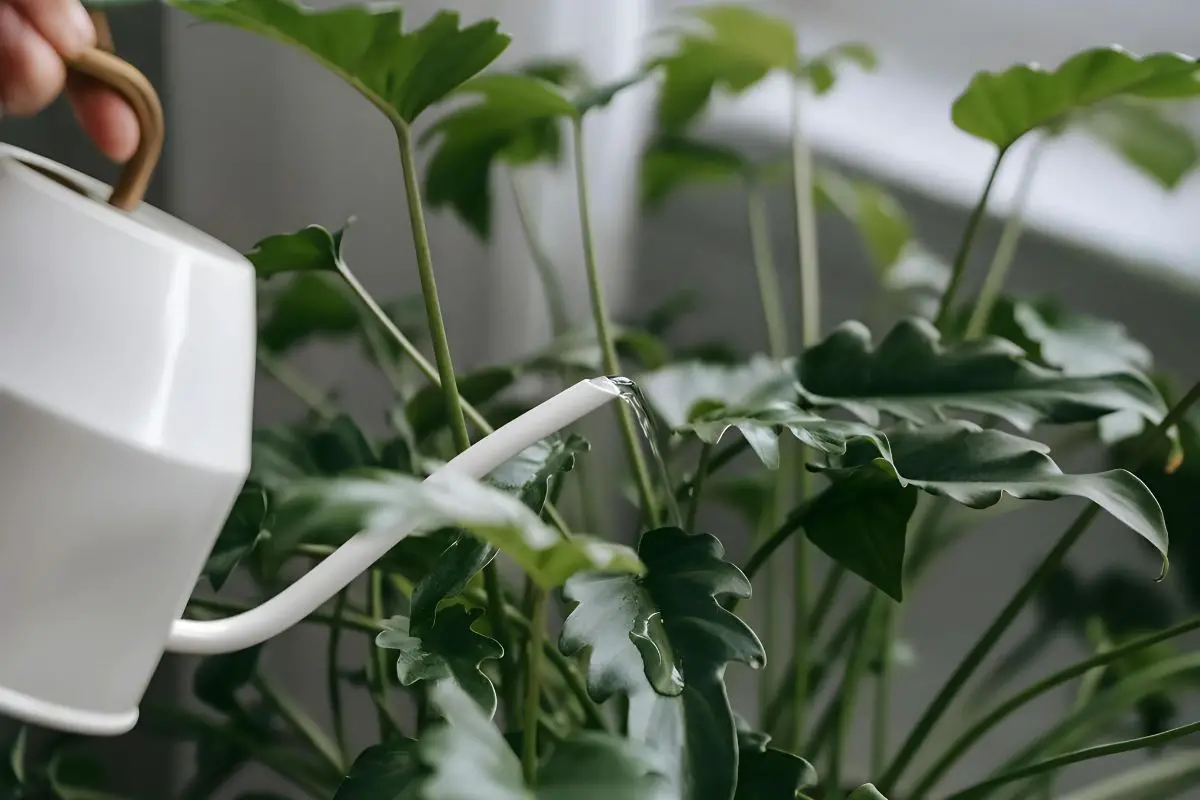White mold is among the most common ailments to plague houseplants, microgreens, crops, and the like. If this is your first time to see the thick, fuzzy, web-like substance covering your plants, you may not know which way to turn. If this has happened to you before, you might feel like you have no idea how to keep it from happening again.
Here’s how you can completely get rid of white mold in soil:
- Physically remove the mold from the pot.
- Repot your plant with new soil.
- Clean out your old pot thoroughly.
- Sterilize your planting soil.
- Use natural antifungal remedies.
- Dry out your potting soil.
- Take preventative measures.
This article will guide you through these seven methods that are guaranteed to help you get rid of white mold in soil for good. In the last sections, I’ll provide you with some additional information regarding the phenomenon, including what causes it and the risks it presents to your plants.

1. Physically Remove the Mold From The Pot
If the infection is minor, you can attempt to get rid of it by physically removing the moldy plant sections and the soil surface. I’d suggest using gloves and a face mask before doing so to ensure you aren’t inhaling any of the white molds.
Scrape the soil surface or cut off the plant sections that are visibly infected and dispose of them properly. Avoid putting infected materials into your compost pile unless you can keep the compost temperatures above 149 °F (65 °C) for at least three weeks.
Check local rules in your municipality regarding burning or the proper disposal of contaminated agricultural waste.
If the infection has already severely infiltrated your plant, this strategy may prove to be a lost cause. In that case, you may need to properly dispose of the entire potting mix, including the plant if the infection is severe and has visibly damaged a significant portion of your plant.
Some severe signs to watch out for include the following:
- Watery rot on roots and leaves
- Web-like or thread-like mycelia on plant stems or leaves
- Pale foliage
- Black masses inside or on the surface of stems
2. Repot Your Plant With New Soil
Another quick, non-committal fix is to repot your plant with new soil. As mentioned above, an infestation of white mold could be climbing through your soil and getting all over your new pot. If this is the case, no amount of tedious mold brushing will get all of it off of your plant, and if it does, it isn’t going to keep working for long.
Repotting a plant with some new and sterile soil in a fresh pot can help give your crops a fresh start. Just make sure to keep an eye out for any remaining white mold, and try to be proactive rather than reactive to infections.
3. Clean Out Your Old Pot Thoroughly
If you don’t want to move your plant into a new pot, you should still think about replacing the soil and giving your pot a nice scrub. You can use something antifungal, like a diluted vinegar or bleach solution, to give your pot a thorough scrub down.
Then, replace the old contaminated soil with fresh new soil as you would in the step above. This time, just place your plant into the old pot and you’ve essentially given your plant a better chance for recovery.
Though you don’t have to follow these steps exactly, the demonstration will give you a better idea of how thoroughly you should be cleaning your pots.
4. Sterilize Your Planting Soil
Sterilizing your plant soil is a great way to get rid of pests, infestations, and fungi. It will deplete your soil completely of microbes, whether beneficial or harmful. This form of soil recycling can save you significant time and effort.
To sterilize your plant soil, you basically have to freeze or heat all forms of life within that soil. For this reason, you’ll want to remove your plant first and keep it in a safe place. Keep in mind that you must repot your plant in fresh, sterile soil.
Recycling soil works similarly to sterilizing or pasteurizing food or water. You want to get it hot or cold to inhibit the lifecycle of any bacteria, virus, or fungi growing inside. Nothing can survive in high heat or frigid temperatures for an extended period. For this reason, you should also thoroughly fertilize and mulch your soil after sterilization.
You can reuse the old contaminated soil later for other plants once you’ve completely treated it and reintroduced nutrients and beneficial microorganisms.
To sterilize your plant’s soil, you can use the following strategies:
Boiling Water
Boiling water is a quick and simple strategy. All you have to do is get your kettle going and then pour hot water over patches of your garden, avoiding plant roots. Then, you can proceed to mulch and fertilize the area to provide the necessary nutrients back to the soil.
Microwave/Oven Sterilization
This method is one of the fastest and most effective ways to sterilize potting soil and eliminate pests like nematodes.
Be mindful when packing the soil so as not to compromise the safety of other materials (especially food) that you heat in the same machine. Still, when done correctly and with the utmost care, this method will work well to completely eliminate white molds.
Here’s how to do it:
- Organize the soil to be heated in batches.
- Put your soil in a microwave or oven-safe dish and cover with foil.
- Heat your plant soil for 20-30 minutes at 180 °F (82 °C) in an oven. Ensure that the temperature doesn’t exceed 200 °F (93 °C).
For microwave sterilization, you can set the machine to high heat for 60-90 seconds.
Freezer Sterilization
Just like the above strategy, you’ll want to put batches of your soil into a dish or Ziploc bag that you can zip to lock out all air. Then, you must put these bags in a freezer for a few days to inhibit any mold growth or life cycle continuation.
5. Use Natural Antifungal Remedies
Before you tap into the chemical fungicides and herbicides, there are dozens of natural antifungal remedies that gardeners across the world have been known to use. Every gardener has their secret go-to, but I’ll explain the science behind each of them.
Possible natural antifungal remedies include:
- Cinnamon
- Baking soda
- Vinegar
- Neem oil
- Mouthwash
- Grapefruit oil
- Food-grade hydrogen peroxide
None of these alternatives is necessarily better than the others, but each does have its own set of pros and cons. Weigh your options and see what works best for you.
On a tough day, even if you’re a big believer that neem oil works best, you may reach for the cinnamon just because it’s what you have on hand. Regardless, these natural antifungal treatments will help inhibit mold growth and stop its spread.
Cinnamon
Cinnamon, ground or otherwise, has been shown to help plant growth and act as an antifungal in your soil. A study found that cinnamon is effective against common plant fungal diseases, including Sclerotinia sclerotiorum, which causes white mold.
After removing the infected leaves and scraping the soil clean of mycelia, you can sprinkle cinnamon on the soil surface.
According to the Microbiology Society, cinnamon oil can be used as an antifungal for plant and human use because it damages the substance’s cell membrane and prevents yeast from spreading.
Baking Soda
Baking soda has also proven to be an effective mold inhibitor in plants. You shouldn’t sprinkle baking soda on your garden, though. Dilute a teaspoon of baking soda in a liter (0.26 gal) of water and lightly mist your plant or garden soil with a fine spray bottle.
Doing this shortly before sunrise can prevent burning the leaves and give your plant’s foliage enough time to dry out.
Vinegar
Using vinegar will be a good go-to, especially if you are worried about using bleach in your kitchen or on your plants.
Bleach can help inhibit mold growth, but it is much too strong to use on a houseplant. Vinegar, although less strong, can be harmful when in contact with any plant part. Therefore, use vinegar solution only when treating contaminated but empty soil.
You can use a little bit of apple cider vinegar, wood vinegar, or distilled vinegar diluted with lots of water to spray or pour on the soil to kill and inhibit mold growth.
Diluting one cup of 5% vinegar in one gallon (3.8 liters) of water should do the trick. However, note that this can acidify your soil temporarily and might not be ideal if you’re aiming to grow an alkaline-loving plant.
Neem Oil
Neem oil is an essential part of a dedicated gardener’s arsenal when it comes to dealing with plant pests and pathogens. It works well in killing fungi but doesn’t necessarily treat diseased plants. Therefore, it should be used as a preventive measure before growing plants in contaminated soil.
Here’s how to use it:
- Mix one tablespoon of neem oil and one tablespoon of liquid soap for every quart (0.9 liters) of water.
- Pour the solution on the soil once a week for 3-4 weeks to inhibit the growth of fungi and make the soil safe for future use.
Food-Grade Hydrogen Peroxide
Hydrogen peroxide is another widely known cure for fungal infections at home and in the garden. However, some people think about applying it to their plants, especially if they’re growing microgreens or edible plants.
Most hydrogen peroxide products are sold at a 35% concentration. You can dilute it to 3% by mixing 1/2 cup (125 ml) of hydrogen peroxide with 5.5 cups (1.3 l) of distilled water. You can then drench your empty soil with this solution to eliminate white mold.
If there are plants on contaminated soil, you can dilute the solution further by mixing 1 cup (250 ml) of the 3% solution with 2 cups (500 ml) of distilled water. This will result in 1% hydrogen peroxide.
When properly diluted to 1%, it’s safe to spray directly on your plants to kill the white mold. Alternatively, you can dip your plant’s roots in the same solution before repotting to ensure your plant won’t have to deal with a recurrence of the disease in its new environment.

6. Dry Out Your Potting Soil
Fungus loves moisture, so drying the soil out and giving it some sun is a great way to get rid of mold.
Mold grows in places that are dark, moist, and cool. Heat and sunlight are their enemies, so drying out your soil in the sun can make your soil safe for growing plants.
However, if the mold has already started growing in soil with plants, remove the plant and spread the soil on a tarp under direct sunlight for 1-2 days without rain.
One downside of this method, though, is that the spores might be blown by the wind. To counter this disadvantage, you can first drench the soil with neem oil solution or 3% hydrogen peroxide to kill the spores before drying the soil under the sun.
Meanwhile, you can treat the plant by removing infected parts and dipping the roots in 1% hydrogen peroxide solution for about 10 minutes before repotting them in fresh soil.
7. Take Preventative Measures
Of course, the best way to get rid of white mold is never to get it in the first place.
When reusing old potting soil, err on the side of caution and sterilize it. You don’t know what kind of diseases are present in it and you don’t want them to affect your new plants.
You must also follow good gardening practices to prevent white mold problems.
Watering Routines & Drainage
You need proper drainage for your soil for many reasons, but preventing mold is one of the most important ones. Moisture and standing water are like magnets for mold. This is why you always need to keep the following in mind:
- Use pots with drainage holes in the bottom.
- Water your plants in the morning to give them enough time to dry throughout the day.
- Avoid getting the foliage wet. Wet leaves can invite pests and harmful microorganisms.
Additionally, proper hydration is an enemy to mold. Overwatering can waterlog your plants and attract mold. You can use a plant moisture meter or read up on how much water your plant needs to avoid this from happening.
Humidity
High humidity is a known cause of mold, whether in plants or your home. If you’ve found mold to be a problem no matter what you do, you might consider getting a dehumidifier. Because your plants still need moisture, you won’t want to put it on your plant rack, but rather somewhere near it.
Alternatively, you can thin your plants when they become overcrowded. This will reduce the humidity around them and improve air circulation, preventing mold growth.
What Is White Mold?
White mold is a thick and fuzzy growth of threadlike mycelia on plant tissue. It covers the length of your plant from the stem to the foliage. Sometimes, you may not notice it on your plant until it wilts, while other times, its presence is painstakingly apparent. You can also see it often on the soil surface.
It is a fungal disease caused by Sclerotinia sclerotiorum. It can be caused by overwatering, poor drainage, and humid conditions. White mold is detrimental to plants and crops, and if the infection is severe, it will require you to toss your plant.
It’s particularly buggy for sunflowers, vegetables, legumes, and fruits but has a broad ecological distribution, meaning it can affect almost any plant, anywhere.
Moreover, scientists have had an extremely difficult time creating crops resistant to white mold. So, you can expect to get it at one point or another.
Common Causes
The fungus that causes white mold thrives in cooler temperatures and moist soil. With climate and drainage issues favorable for fungal growth, white mold can even form mushrooms, which will spread spores and affect all of your surrounding plants.
Your plant could’ve gotten infected by this condition while outside because it’s placed under ideal climate conditions for fungal growth. Spores can also spread outdoors on windy days so a white mold infection in your neighbor’s garden can easily get to yours.
Effects of Mold on Your Plants’ Health
Whether airborne, created with the perfect conditions, or coming from a nearby plant, white mold spreads like wildfire. It won’t kill your plant automatically, instead, it inhibits your plant’s growth and weakens it.
However, if the mold spreads throughout the soil and through the roots, you might be better off just tossing your plant. Large infestations of white mold are more challenging to get rid of by scale, and it might be simpler just to start fresh.
It also bears mentioning that if you find white mold on your plant and are willing to do what you can to revive it, you should still isolate it from other plants while treating it. The infection could become airborne and affect more of your houseplants given the right conditions.
Final Thoughts
White mold can be detrimental to even the strongest plants, which is why knowing how to completely remove it is a piece of knowledge that should be in every gardener’s arsenal. Luckily, as long as you catch the infestation early, you’ll likely be able to rid your soil of it by following one (or more) of these simple steps.







